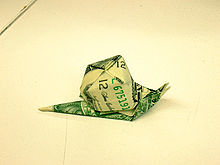- Origami paper
-
 Origami paper and a traditional origami crane
Origami paper and a traditional origami crane
Origami paper is used to fold origami, the art of paper folding.
Contents
Kami
This paper is the easiest to find and cheapest to buy. It is also the most basic: kami, or koi paper. Kami is a thin, easy to fold paper. It is usually printed only on one side, with a solid color or pattern. These patterns can be as simple as a gradation from red to blue, or as complex as a multi-colored kimono pattern of flowers and cranes with gold foil embellishments. Kami comes in several sizes, but standard sizes include 75 × 75 mm (about 3 × 3 inches), 6-inch squares and 10-inch squares.
Origamido
Meaning the "Way of paper folding," this hand made paper is created by Micheal Lafosse specifically for origami. It is considered the best origami paper for its thinness and strength.
Paper-backed foil
This medium is a slightly more expensive, flashier, paper that is good for retaining creases called paper-backed foil paper, Japanese foil, or simply foil. Foil paper is composed of a thin layer of foil adhered to an extremely thin sheet of paper. The most common colors are silver and gold, but any color is possible in foil paper including bright pink, blue and copper. In many multi-color packs, one sheet each of silver and gold paper is included. These are usually placed on the bottom end of the string if used in a thousand origami cranes.
Washi
Washi is a thick hand-made paper, available commercially but very expensive. Washi is a long-fibred paper but is also very soft. It does not hold a sharp fold due to the extremely long and thick fibres of the pulp. Inclusions of flowers, leaves, grass, seeds, string, ribbon, and other small decorative items are common for washi, adding to the random and handmade appearance of the finished craft. Washi is also accepting of ink, making it easy to print upon. Printed washi has a uniquely shiny, uneven and occasionally transparent texture. In origami it is not as commonly used as kami paper.
Chiyogami
Chiyogami (literally "1000 generation paper") is an inexpensive alternative to washi paper. It is a traditional block-printed paper.
Specialty fiber
For supercomplex origami, many folders choose a special, handmade, thin paper made of strong fibers, such as unryu, lokta, saa, and abaca. However, to properly fold out of these papers, often methylcellulose or methyl acetate is brushed over the paper and dried, to properly prepare the fibers for wet-folding.
Dollar bills and banknotes
Banknotes may be used to fold models as well. Banknotes are common media for folding as the subject in the center of the banknote, like George Washington, can make a striking appearance on the finished model.
Wikimedia Foundation. 2010.

